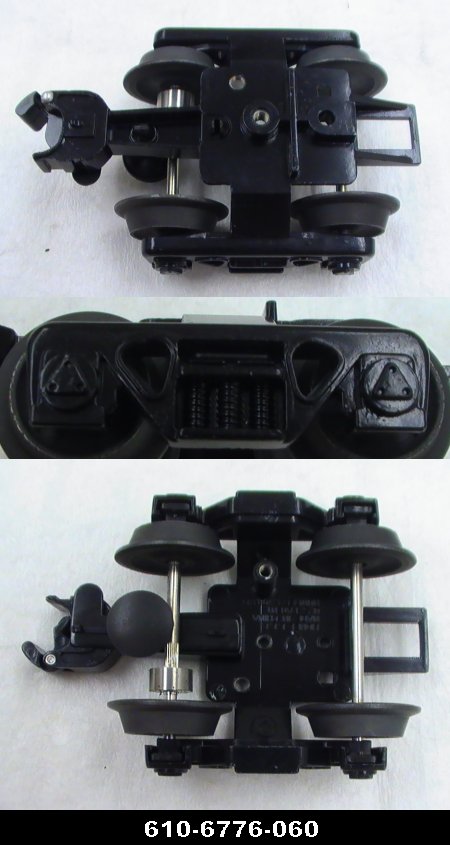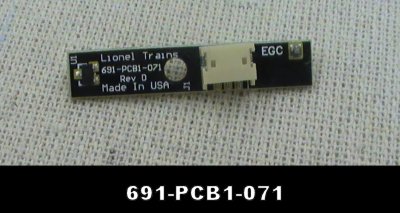I have a couple old 80s Rail sounds boxcars which I guess were state of the art then but the only sound they came close to emulating was a Civil War woodburner. Chuff rate of 1. I got a newer one with much better sound but the chuff rate is about 1-1/3. Any way to increase the chuff rate without tearing then apart?
Replies sorted oldest to newest
It would be very helpful to include a model number. Most early chuff sounds were triggered by a switch operated by a cam of some sort on one of the axles. So, without some major surgery, the answer to your question is no.
Dan has the correct answer. Without some surgery, that ain't happening.
Also, when you ask questions like this, it's very useful to include actual model numbers so we have something to go on.
The chuff rate is generated by the wheel and rotating magnet. In theory adding different numbers of poles to that rotating magnet would change the chuff rate.
I'm not sure if different wheel sets had different numbers of magnetic poles (example a simple axle and wheelset change). I know that more modern ones have much smaller diameter magnet hub than the older original that you probably have on that older car.
FWIW, I do understand the desire as early on, I too wanted to use the railsounds boxcars to add sounds to trains that did not have them. I also have gotten some of the railsounds tenders for conventional engines.
I think possibly at least one of your railsounds boxcars is this https://www.lionelsupport.com/...am-RailSounds-Boxcar
6-19886
That little cylinder or hub on the axle is the magnet that triggers the chuff sound with rotation of the wheel

This tiny sensor at the tip of this circuit board is a Hall effect sensor that detects the specific magnetic poles of that rotating magnet ring on the axle.

Although I haven't tried it, maybe swapping out the wheelset with the magnet wheel on it and using two small magnets glued to a wheel might allow you to increase the chuff rate. You might also have to tinker with the spacing of the hall effect sensor to get it to work, it would depend on the strength of the magnets selected.
It's the 6-16649. Are there upgrades to these old railsounds available?
That's a 30 year old product, I'm sure Lionel would rather forget those than try to update them. ![]() I'm also sure there are no supported upgrades.
I'm also sure there are no supported upgrades. ![]()
Back in the day (late 80's) when these came out, there was a way to remove one solder connection on the circuit board to double the chuff rate. I know I did that to a Rock Island steam sound boxcar that I had.
Ouch. Okay here it comes. Recall which solder joint?
@Bob posted:Back in the day (late 80's) when these came out, there was a way to remove one solder connection on the circuit board to double the chuff rate. I know I did that to a Rock Island steam sound boxcar that I had.
Edited corrections:
A little searching, I found that info on that modification. Only applies to a specific Railsounds 1.0
That said, I think your car 6-16649 is maybe also an early Railsounds 1.0 and thus the same info may apply?
Thanks to @JohnActon
https://ogrforum.com/...1#158111058791489101
FYI, also in that same thread @Mark V. Spadaro posted this physical picture so you have another frame of reference.
I've combined the 2 images to help
Attachments
@Vernon Barry posted:A little searching, I found that info on that modification. Only applies to a specific Railsounds 1.0 that I mentioned earlier
https://www.lionelsupport.com/...am-RailSounds-Boxcar
6-19886
That said, I think your car 6-16649 is maybe also an early Railsounds 1.0 and thus the same info may apply?
The 6-19886 car you reference is a RailSounds 3.0 model from 1997, here's the parts list from that page.

Attachments
@gunrunnerjohn posted:The 6-19886 car you reference is a RailSounds 3.0 model from 1997, here's the parts list from that page.
Yes, I got a little confused trying to grab information from multiple sources.
The car referenced in the modification topic was:
Lionel 6-16631 Rock Island Steam Railsounds Boxcar
The car mentioned in this topic is:
Lionel 6-16649 REA RAILWAY EXPRESS STEAM RAILSOUNDS BOXCAR
Both appear to be Railsounds 1.0
Vernon Barry. Jumpin' jehosaphat (sorry, I've been around a while). IT WORKED! Even though technically not real, the chuff rate of 2 is good for model rr. Thanks a lot!
Cool that the upgrade works. ![]()
@jps32016 posted:Vernon Barry. Jumpin' jehosaphat (sorry, I've been around a while). IT WORKED! Even though technically not real, the chuff rate of 2 is good for model rr. Thanks a lot!
Sometimes good stuff happens.![]()
Truthfully, two chuffs from the boxcar wheel probably is at least four chuffs for the drivers. ![]()
Sadly in this early car the steam sounds were pretty bad. The closest thing it resembled was a Civil War wood burner (General).
Doing this from memory, but I think this is right.
For the RailSounds 1 cars, the axle with magnet assembly has two magnetic sections. From the factory, the RailSounds 1 boards ignore every other magnetic activation. The "fix" that Vernon posted above tells the board to indeed chuff with every magnetic activation instead of every other one.
On the RailSounds 2 through RailSounds 4 cars, the axle with magnet assembly has one magnetic section. (This is roughly equivalent to two chuffs per revolution of a steam loco's drivers.) The axle magnet is larger, and looks the same as the one used with RailSounds 1, except the number of magnetic sections differs.
Where things really get weird is on RailSounds 4 cars and later. Lionel's Chinese manufacturer switched to a physically smaller magnet as shown above with two magnetic sections. The problem is that they kept the same part number for reasons unknown. FYI -- due to the difference in size as well the number of magnetic sections, they are NOT compatible with each other.
TRW
Interesting. The Railsounds 1 car chuffs beautifully now, except for the tinny steam. I also have the newer 6-26860 Trainsounds car. Sound is far superior and it does have the smaller magnet wheel. It chuffs slightly faster than the factory setting of the old car, but I assume there's no way to speed it up?
Addendum: Upon further analysis I discovered the chuff rate was now 3! Just a shame the steam sound was so primitive.
Well, synchronizing the cars to a totally unrelated locomotive is not that easy, so it's no surprise they don't match up. Truthfully, the RailSounds cars were really just made for the less discerning customer. ![]()
They were pricey enough at the time 😐
@PaperTRW posted:Doing this from memory, but I think this is right.
For the RailSounds 1 cars, the axle with magnet assembly has two magnetic sections. From the factory, the RailSounds 1 boards ignore every other magnetic activation. The "fix" that Vernon posted above tells the board to indeed chuff with every magnetic activation instead of every other one.
On the RailSounds 2 through RailSounds 4 cars, the axle with magnet assembly has one magnetic section. (This is roughly equivalent to two chuffs per revolution of a steam loco's drivers.) The axle magnet is larger, and looks the same as the one used with RailSounds 1, except the number of magnetic sections differs.
Where things really get weird is on RailSounds 4 cars and later. Lionel's Chinese manufacturer switched to a physically smaller magnet as shown above with two magnetic sections. The problem is that they kept the same part number for reasons unknown. FYI -- due to the difference in size as well the number of magnetic sections, they are NOT compatible with each other.
TRW
Would those smaller magnet wheels work if you shimmed the sensor closer? I would rather have 2 chuffs per rev I think.
Nope. Loosened the sensor screw and moved it much closer but didn't change. In manually moving the cars over a few sections of track, the new Trainsounds car registered 10 chuffs, while the reconfigured Railsounds 1 car delivered 17.
@jps32016 posted:They were pricey enough at the time 😐
You missed my basic point. The cost could be anything, matching chuffs to an unknown locomotive with unknown driver diameters is an impossible feat. If you picked the right locomotive, say a switcher with smaller wheels, that 3-chuffs could easily be 4-chuffs, or even 5-chuffs.
No I understand. I'm just saying in the mid 80s that was what was available. I was just surprised that there was a way to increase the chuff rate not commonly known. In my railroad car layout (strasburgmuseum.org) the old Railsounds car sounds reasonable for my "General" loco.
Well, yes. That's why I don't have any mid-80's stuff left. ![]()
Sorry for the messy layout always under construction,way too much sitting around parked.
Boxcar as delivered with the solder blob jumper as stock. This is a Railsounds 1.0 version boxcar for reference.
Now after removing the solder blob jumper

Attachments
Sounds so much better! Thanks, Vernon!
Yep. That's exactly what I got. I have two cars. I replaced the shell of one with a homemade civil war era box car shell and use it with my Dry Gulch "General." The tender was "V&T (Virginia Truckee)." I just changed the passenger cars to Virginia and Tennessee. I just wish there was a way to speed up the newer Lionel Trainsounds car.
Wow!
Just sucked out that solder bridge on mine. Doubled the cuff rate.
Lionel 6-16639 (1991)
Thank you so much.
John






